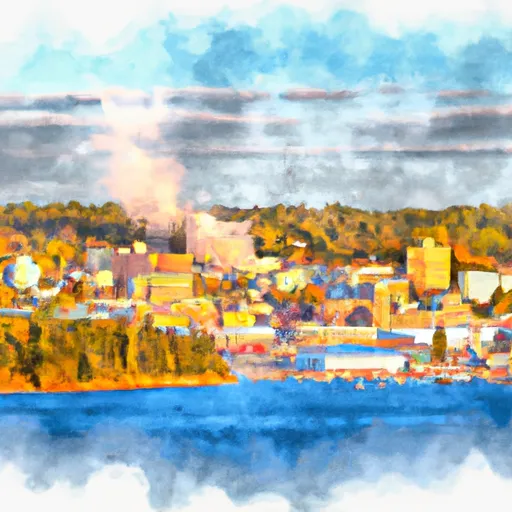-
 Snoflo Premium
Snoflo Premium
Get unlimited access to all our content
With no Ad interruptions! - Start Your Free Trial Login with existing account
Grand-Portage
Eden Index
Climate
4.9
•
Recreation
5.3
•
Community
•
Safeguard
3.8/10

Grand Portage is a small town in Minnesota with a population of approximately 500 people. The climate in Grand Portage is cold and temperate, with an average temperature of 40°F. The town is situated near the Grand Portage National Monument, a historic site that marks an old fur trade route. The area also features beautiful natural scenery, including forests, lakes, and streams. The Pigeon River runs through Grand Portage and provides opportunities for fishing, kayaking, and boating. The river is also home to several species of fish, including walleye and lake trout. Outdoor recreation opportunities in the area include hiking, camping, and wildlife viewing.
What is the Eden Index?
The Snoflo Eden Index serves as a comprehensive rating system for regions, evaluating their desirability through a holistic assessment of climate health, outdoor recreation opportunities, and natural disaster risk, acknowledging the profound impact of these factors on livability and well-being.
Climate Health Indicator (CHI): 4.9
Grand-Portage receives approximately
752mm of rain per year,
with humidity levels near 81%
and air temperatures averaging around
4°C.
Grand-Portage has a plant hardyness factor of
4, meaning
plants and agriculture in this region thrive during a short period during spring and early summer. Most
plants will die off during the colder winter months.
By considering the ideal temperature range, reliable water supplies, clean air, and stable seasonal rain or snowpacks, the Climate Health Indicator (CHI) underscores the significance of a healthy climate as the foundation for quality living.
A healthy climate is paramount for ensuring a high quality of life and livability in a region, fostering both physical well-being and environmental harmony. This can be characterized by ideal temperatures, reliable access to water supplies, clean air, and consistent seasonal rain or snowpacks.
Weather Forecast
Streamflow Conditions
Northwestern Lake Superior
Area Rivers
Northwestern Lake Superior
Snowpack Depths
Northwestern Lake Superior
Reservoir Storage Capacity
Northwestern Lake Superior
Groundwater Levels
Recreational Opportunity Index (ROI): 5.3
The Recreational Opportunity Index (ROI) recognizes the value of outdoor recreational options, such as parks, hiking trails, camping sites, and fishing spots, while acknowledging that climate plays a pivotal role in ensuring the comfort and consistency of these experiences.
Access to outdoor recreational opportunities, encompassing activities such as parks, hiking, camping, and fishing, is crucial for overall well-being, and the climate plays a pivotal role in enabling and enhancing these experiences, ensuring that individuals can engage in nature-based activities comfortably and consistently.
Camping Areas
| Campground | Campsites | Reservations | Toilets | Showers | Elevation |
|---|---|---|---|---|---|
| Walkiah Bluff Water Park | None | 38 ft | |||
| DLo Water Park | None | 312 ft | |||
| St. Bernard State Park | None | 3 ft | |||
| Lake Mike Conner | 20 | 314 ft | |||
| Dry Creek Water Park | None | 514 ft | |||
| Roosevelt State Park | None | 562 ft | |||
| Simpson County Lake | 11 | 427 ft | |||
| Okatoma Water Park | None | 396 ft | |||
| Lake Columbia | 12 | 212 ft | |||
| Lake Ross Barnett | 22 | 402 ft |
Nearby Ski Areas
Catastrophe Safeguard Index (CSI):
The Catastrophe Safeguard Index (CSI) recognizes that natural disaster risk, encompassing floods, fires, hurricanes, and tornadoes, can drastically affect safety and the overall appeal of an area.
The level of natural disaster risk in a region significantly affects safety and the overall livability, with climate change amplifying these risks by potentially increasing the frequency and intensity of events like floods, fires, hurricanes, and tornadoes, thereby posing substantial challenges to community resilience and well-being.
Community Resilience Indicator (CRI):
The Community Resilience Indicator (CRI) recognizes that education, healthcare, and socioeconomics are crucial to the well-being of a region. The CRI acknowledges the profound impact of these elements on residents' overall quality of life. By evaluating educational resources, healthcare accessibility, and economic inclusivity, the index captures the essential aspects that contribute to a thriving community, fostering resident satisfaction, equity, and social cohesion.

